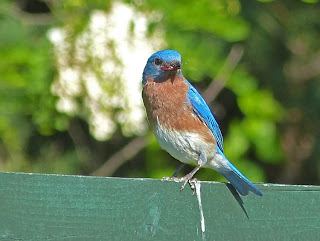"There's a baby owl/possum/fawn/skunk in my yard. What should I do? Can you come and get it?"
Patty Bleau, our office coordinator at Creasey Mahan Nature Preserve, often receives calls like this during the spring. Since we used to host a raptor rehab organization on the property, it's not hard to figure out why people call us when they find a baby animal. That organization has been gone for many years, but Patty is always glad to give those callers the name and number of active rehabilitators in the area.
So, what should you do when you find a young animal? After all, we always want to save those cute little orphans. First, we must determine if the baby is actually an orphan or not. Brigette Williams runs Second Chances Wildlife Center in Oldham County, KY, specializing in mammals, and sums up all the factors in deciding whether the animal needs help or not. Around 50% of all animals rehabilitators receive are animals that did not need to be rescued. Many well-meaning people rescue an orphaned animal that does not need to be rescued. Animals make terrific mothers and their babies are always better kept with them versus humans.
DO NOT rescue wildlife and then KEEP (kidnap) the bird or animal for a possible pet. State and federal laws protect nearly all wild mammals and birds. It is against the law to possess the animal or bird or the nests, feathers, or eggs of a bird without special permits. High fines and possible jail time are often given. In addition, dietary needs of each species of animal are different and it is almost impossible to duplicate their needs in captivity without special training. Mother deer in particular, will hide their fawns in a safe place while they go to feed. Since fawns have NO ODOR, and their natural instinct is "freeze behavior" for the first two weeks of their lives, it is unlikely they will be found by dogs or coyotes (unless tripped over). Staying with her fawn would give away its hiding place.
You are permitted to put an animal/bird in a box to keep it safe from cats and dogs while contacting a licensed rehabilitator. Keep the baby or injured animal WARM and CONTAINED and QUIET. Put tissues or towels in the box or bag to keep it warm, and cover it. Darkness makes the animal feel more secure. Loud noises are scary, so keep that in mind when selecting a spot for the box. Keep it out of drafts and away from air conditioners. The box can be placed half on and half off a heating pad set on low. If the animal gets too warm it can move to the other end of the box. A water bottle filled with warm water taped (to prevent rolling around) to the inside of the box will work just as well.
Birds on the ground are learning to fly. This is called fledging. Some bird species such as robins and blue jays remain on the ground for weeks. These birds look clumsy and injured. Unless you see a visible injury, please leave the fledglings to learn on their own. Mothers are often close by. Cats and dogs are the fledgling’s worry. Please keep your cat or dog indoors during this time. If you see a fledgling on the street, gently place it under a bush in a cat or dog free area. Birds that have fallen out of the nest can be placed back in. These birds will have little or no feathers. If the nest is destroyed, then make a nest from a Tupperware type bowl with paper towel inside and vent holes. Place the “nest” back in the tree. ALL ANIMALS will avoid coming to retrieve their babies if humans are around. Please watch for signs of mom without being too close or animals seeing you.
DO NOT FEED THE ANIMAL FOOD, WATER, OR MILK! Water and milk can go down into the animal’s lungs and kill it. Feeding an animal or bird the wrong food can cause severe diarrhea, dehydration, and even death. If an animal or bird has been caught by a cat or dog, please call Second Chances immediately. Even if wounds are not visible, the animal or bird needs to be given antibiotics. This young Turkey Vulture was "saved" by people who fed it hot dogs. It died of metabolic bone disease, after almost every bone in its body had broken. Raptors need to eat bones and fur, i.e., the whole mouse. How many of you keep mice and rats in the freezer?
All animals "imprint" on their parents so they know how to behave like the animal they are. When their vision clears, the first big thing that feeds them in Mama. However, each species has a different period of time after birth when imprinting takes place. A human imprint animal has rough time if it is released. Raptors, for example, just can't figure out how to hunt for themselves, and when it's time to find a mate, they want a girl just like Mom, who was a human being. At Raptor Rehabilitation of Kentucky, Inc., birds in danger of imprinting are fed by volunteers wearing a camouflage suit, so the bird doesn't get imprinted.
OK, so who should I call when I find a baby that appears to need help? Here are some licensed local rehabbers and Animal Control. Please, please be patient, and leave a clear message with your name, address, phone number and the kind of animal that needs help. Most rehabbers specialize in birds or mammals. They all work with volunteers, and it may take a while for someone to contact you.
Second Chances Wildlife Rehab (502) 228-6333
Oldham County Animal Control (502) 222-7387
Raptor Rehab of Ky (502) 491-1939
Wingspan of Kentucky (502) 228-9034
















